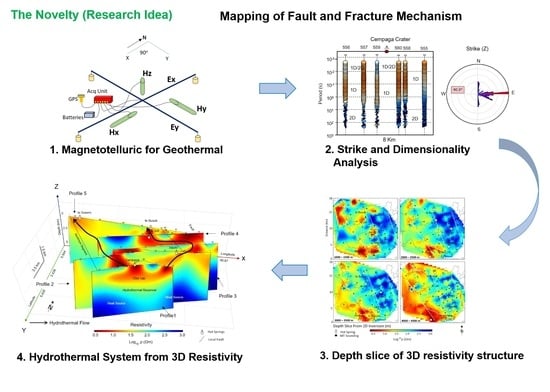Mapping of Fault and Hydrothermal System beneath the Seulawah Volcano Inferred from a Magnetotellurics Structure
Abstract
1. Introduction
2. Seulawah Agam Geothermal Field
3. Magnetotelluric Studies
3.1. Overview of the Magnetotellurics Method
3.2. Magnetotellurics Data Acquisition
3.3. Strike and Dimensionality Analysis
4. Results and Discussion
4.1. Data Response
4.2. One-Dimensional Inversion
4.3. Two-Dimensional Occam Inversion
4.4. Hydrothermal System from Three-Dimensional Resistivity
4.5. Discussion
5. Conclusions
Author Contributions
Funding
Institutional Review Board Statement
Informed Consent Statement
Data Availability Statement
Acknowledgments
Conflicts of Interest
References
- Moya, D.; Aldás, C.; Kaparaju, P. Geothermal energy: Power plant technology and direct heat applications. Renew. Sustain. Energy Rev. 2018, 94, 889–901. [Google Scholar] [CrossRef]
- Maithya, J.; Fujimitsu, Y. Analysis and interpretation of magnetotelluric data in characterization of geothermal resource in Eburru geothermal field, Kenya. Geothermics 2019, 81, 12–31. [Google Scholar] [CrossRef]
- Hacıoğlu, Ö.; Başokur, A.T.; Diner, Ç. Geothermal potential of the eastern end of the Gediz basin, western Anatolia, Turkey revealed by three-dimensional inversion of magnetotelluric data. Geothermics 2021, 91, 102040. [Google Scholar] [CrossRef]
- Sani, A.K.; Singh, R.M.; Amis, T.; Cavarretta, I. A review on the performance of geothermal energy pile foundation, its design process and applications. Renew. Sustain. Energy Rev. 2019, 106, 54–78. [Google Scholar] [CrossRef]
- Pan, S.Y.; Gao, M.; Shah, K.J.; Zheng, J.; Pei, S.L.; Chiang, P.C. Establishment of enhanced geothermal energy utilization plans: Barriers and strategies. Renew. Energy 2019, 132, 19–32. [Google Scholar] [CrossRef]
- Mikhailenko, A.V.; Ruban, D.A. Geo-heritage specific visibility as an important parameter in Geo-Tourism resource evaluation. Geosciences 2019, 9, 146. [Google Scholar] [CrossRef]
- Marwan; Yanis, M.; Muzakir; Nugraha, G.S. Application of QR codes as a new communication technology and interactive tourist guide in Jaboi, Sabang. In IOP Conference Series: Materials Science and Engineering; Institute of Physics Publishing: Bristol, UK, 2020; Volume 796. [Google Scholar]
- Seyedrahimi-Niaraq, M.; Doulati Ardejani, F.; Noorollahi, Y.; Jalili Nasrabadi, S.; Hekmatnejad, A. An unsaturated three-dimensional model of fluid flow and heat transfer in NW Sabalan geothermal reservoir. Geothermics 2021, 89, 101966. [Google Scholar] [CrossRef]
- Hochstein, M.P.; Sudarman, S. History of geothermal exploration in Indonesia from 1970 to 2000. Geothermics 2008, 37, 220–266. [Google Scholar] [CrossRef]
- Held, S.; Schill, E.; Schneider, J.; Nitschke, F.; Morata, D.; Neumann, T.; Kohl, T. Geochemical characterization of the geothermal system at Villarrica volcano, Southern Chile; Part 1: Impacts of lithology on the geothermal reservoir. Geothermics 2018, 74, 226–239. [Google Scholar] [CrossRef]
- Leveni, M.; Manfrida, G.; Cozzolino, R.; Mendecka, B. Energy and exergy analysis of cold and power production from the geothermal reservoir of Torre Alfina. Energy 2019, 180, 807–818. [Google Scholar] [CrossRef]
- Cheng, Y.; Zhang, Y.; Yu, Z.; Hu, Z. Investigation on Reservoir stimulation characteristics in hot dry rock geothermal formations of china during hydraulic fracturing. Rock Mech. Rock Eng. 2021, 54, 3817–3845. [Google Scholar] [CrossRef]
- Wang, G.-L.; Zhang, W.; Ma, F.; Lin, W.J.; Liang, J.Y.; Zhu, X. Overview on hydrothermal and hot dry rock researches in China. China Geol. 2018, 1, 273–285. [Google Scholar] [CrossRef]
- Eggertsson, G.H.; Lavallée, Y.; Kendrick, J.E.; Markússon, S.H. Improving fluid flow in geothermal reservoirs by thermal and mechanical stimulation: The case of Krafla volcano, Iceland. J. Volcanol. Geotherm. Res. 2020, 391. [Google Scholar] [CrossRef]
- Yanis, M.; Novari, I.; Zaini, N.; Marwan; Pembonan, A.Y.; Nizamuddin. OLI and TIRS sensor platforms for detection the geothermal prospecting in Peut Sagoe volcano, Aceh Province, Indonesia. In Proceedings of the 2020 International Conference on Electrical Engineering and Informatics (ICELTICs), Aceh, Indonesia, 27–28 October 2020; IEEE: Piscataway, NJ, USA, 2020; pp. 1–6. [Google Scholar]
- Mia, M.B.; Fujimitsu, Y.; Nishijima, J. Exploration of hydrothermal alteration and monitoring of thermal activity using multi-source satellite images: A case study of the recently active Kirishima volcano complex on Kyushu Island, Japan. Geothermics 2019, 79, 26–45. [Google Scholar] [CrossRef]
- Zaini, N.; Irwandi, I.; Abdullah, F.; Meer, F. Van Der Infrared spectroscopy characteristics of mount Sinabung volcanic materials, North Sumatra, Indonesia. In Proceedings of the 3rd International Conference on Natural and Environmental Sciences, Banda Aceh, Indonesia, 26–27 July 2019. [Google Scholar]
- Idroes, R.; Yusuf, M.; Alatas, M.; Subhan; Lala, A.; Muhammad; Suhendra, R.; Idroes, G.M.; Marwan. Geochemistry of sulphate spring in the Ie Jue geothermal areas at Aceh Besar district, Indonesia. In IOP Conference Series: Materials Science and Engineering; Institute of Physics Publishing: Bristol, UK, 2020. [Google Scholar]
- Apollaro, C.; Caracausi, A.; Paternoster, M.; Randazzo, P.; Aiuppa, A.; De Rosa, R.; Fuoco, I.; Mongelli, G.; Muto, F.; Vanni, E.; et al. Fluid geochemistry in a low-enthalpy geothermal field along a sector of southern Apennines chain (Italy). J. Geochem. Explor. 2020, 219, 106618. [Google Scholar] [CrossRef]
- Arzate, J.; Corbo-Camargo, F.; Carrasco-Núñez, G.; Hernández, J.; Yutsis, V. The Los Humeros (Mexico) geothermal field model deduced from new geophysical and geological data. Geothermics 2018, 71, 200–211. [Google Scholar] [CrossRef]
- Marwan; Yanis, M.; Idroes, R.; Ismail, N. 2D inversion and static shift of MT and TEM data for imaging the geothermal resources of Seulawah Agam Volcano, Indonesia. Int. J. GEOMATE 2019, 17. [Google Scholar] [CrossRef]
- Liotta, D.; Brogi, A.; Ruggieri, G.; Zucchi, M. Fossil vs. active geothermal systems: A field and laboratory method to disclose the relationships between geothermal fluid flow and geological structures at depth. Energies 2021, 14, 933. [Google Scholar] [CrossRef]
- Wu, C.; Hu, X.; Wang, G.; Xi, Y.; Lin, W.; Liu, S.; Yang, B.; Cai, J. Magnetotelluric imaging of the Zhangzhou Basin geothermal zone, Southeastern China. Energies 2018, 11, 2170. [Google Scholar] [CrossRef]
- Hartono, D.; Hastuti, S.H.; Halimatussadiah, A.; Saraswati, A.; Mita, A.F.; Indriani, V. Comparing the impacts of fossil and renewable energy investments in Indonesia: A simple general equilibrium analysis. Heliyon 2020, 6. [Google Scholar] [CrossRef]
- Nugraha, R.P.; O’Sullivan, J. A key process of natural state modeling: 3D Geological model of Jaboi Geothermal field, Nangro Aceh Darussalam, Indonesia. In Proceedings of the 7th ITB International Geothermal Workshop (IIGW2018), Bandung, Indonesia, 21–22 March 2018. [Google Scholar]
- Marwan; Idroes, R.; Yanis, M.; Idroes, G.M.; Syahriza, A. Low-Cost UAV based application for identify and mapping a geothermal feature in Ie Jue Manifestation, Seulawah Volcano, Indonesia. Int. J. GEOMATE 2021, 20, 135–142. [Google Scholar] [CrossRef]
- Zaini, N.; Yanis, M.; Marwan; Isa, M.; van der Meer, F. Assessing of land surface temperature at the Seulawah Agam volcano area using the landsat series imagery. J. Phys. Conf. Ser. 2021, 1825, 012021. [Google Scholar] [CrossRef]
- Idroes, R.; Yusuf, M.; Saiful, S.; Alatas, M.; Subhan, S.; Lala, A.; Muslem, M.; Suhendra, R.; Idroes, G.M.; Marwan, M.; et al. Geochemistry exploration and geothermometry application in the North Zone of Seulawah Agam, Aceh Besar District, Indonesia. Energies 2019, 12, 4442. [Google Scholar] [CrossRef]
- Ismail, N.; Yanis, M.; Idris, S.; Abdullah, F.; Hanafiah, B. Near-surface fault structures of the Seulimuem Segment based on electrical resistivity model. J. Phys. Conf. Ser. 2017, 846, 12016. [Google Scholar] [CrossRef]
- Lai, Y.M.; Chung, S.L.; Ghani, A.A.; Murtadha, S.; Lee, H.Y.; Chu, M.F. Mid-Miocene volcanic migration in the westernmost Sunda arc induced by India-Eurasia collision. Geology 2021, 49, 713–717. [Google Scholar] [CrossRef]
- Ledo, J.; García-Merino, M.; Larnier, H.; Slezak, K.; Piña-Varas, P.; Marcuello, A.; Queralt, P.; Pérez, N.M.; Schmincke, H.U.; Sumita, M. 3D electrical resistivity of Gran Canaria Island using magnetotelluric data. Geothermics 2021, 89. [Google Scholar] [CrossRef]
- Cherkose, B.A.; Saibi, H. Investigation of the Ayrobera geothermal field using 3D magnetotelluric data inversion, Afar depression, NE Ethiopia. Geothermics 2021, 94. [Google Scholar] [CrossRef]
- Mohan, K.; Chaudhary, P.; Kumar, G.P.; Kothyari, G.C.; Choudhary, V.; Nagar, M.; Patel, P.; Gandhi, D.; Kushwaha, D.; Rastogi, B.K. Magnetotelluric Investigations in Tuwa-Godhra Region, Gujarat (India). Pure Appl. Geophys. 2018, 175, 3569–3589. [Google Scholar] [CrossRef]
- Daud, Y.; Nuqramadha, W.A.; Fahmi, F.; Sesesega, R.S.; Fitrianita; Pratama, S.A.; Munandar, A. Resistivity characterization of the Arjuno-Welirang volcanic geothermal system (Indonesia) through 3-D Magnetotelluric inverse modeling. J. Asian Earth Sci. 2019, 174, 352–363. [Google Scholar] [CrossRef]
- Ruiz-Aguilar, D.; Tezkan, B.; Arango-Galván, C.; Romo-Jones, J.M. 3D inversion of MT data from northern Mexico for geothermal exploration using TEM data as constraints. J. Appl. Geophys. 2020, 172. [Google Scholar] [CrossRef]
- Marwan; Syukri, M.; Idroes, R.; Ismail, N. Deep and shallow structures of geothermal Seulawah Agam based on electromagnetic and magnetic data. Int. J. GEOMATE 2019, 16, 141–147. [Google Scholar] [CrossRef]
- Sieh, K.; Natawidjaja, D. Neotectonics of the Sumatran fault, Indonesia. J. Geophys. Res. Solid Earth 2000, 105, 28295–28326. [Google Scholar] [CrossRef]
- Rizal, M.; Ismail, N.; Yanis, M.; Muzakir; Surbakti, M.S. The 2D resistivity modelling on north sumatran fault structure by using magnetotelluric data. IOP Conf. Ser. Earth Environ. Sci. 2019, 364, 12036. [Google Scholar] [CrossRef]
- Yanis, M.; Faisal, A.; Yenny, A.; Muzakir, Z.; Abubakar, M.; Nazli, I. Continuity of great sumatran fault in the marine area revealed by 3D inversion of gravity data. J. Teknol. 2020, 83, 145–155. [Google Scholar] [CrossRef]
- Marwan; Asrillah; Yanis, M.; Furumoto, Y. Lithological identification of devastated area by Pidie Jaya earthquake through poisson’s ratio analysis. Int. J. GEOMATE 2019, 17, 210–216. [Google Scholar] [CrossRef]
- Yanis, M.; Abdullah, F.; Zaini, N.; Ismail, N. The northernmost part of the Great Sumatran Fault map and images derived from gravity anomaly. Acta Geophys. 2021, 69, 795–807. [Google Scholar] [CrossRef]
- Bennett, J.D.; Bridge, N.R.; Djunuddin, A.; Ghazali, S.A.; Jeffery, D.H.; Keats, W.; Rock, N.M.S.; Thompson, S.J.; Whandoyo, R. The geology of the Banda Aceh Quadrangle, Sumatra-Geological research and development centre, Bandung. Explan. Note 1981, 19. [Google Scholar]
- Yanis, M.; Marwan, M.; Paembonan, A.Y.; Yudhyantoro, Y.; Rusydy, I.; Idris, S.; Asrillah, A. Geophysical and geotechnical approaches in developing subsurface model for gas power plant foundation. Indian Geotech. J. 2021. [Google Scholar] [CrossRef]
- Siripunvaraporn, W.; Egbert, G. WSINV3DMT: Vertical magnetic field transfer function inversion and parallel implementation. Phys. Earth Planet. Inter. 2009, 173, 317–329. [Google Scholar] [CrossRef]
- Zhang, L.; Hao, T.; Xiao, Q.; Wang, J.; Zhou, L.; Qi, M.; Cui, X.; Cai, N. Magnetotelluric investigation of the geothermal anomaly in Hailin, Mudanjiang, northeastern China. J. Appl. Geophys. 2015, 118, 47–65. [Google Scholar] [CrossRef][Green Version]
- Vozoff, K. Electromagnetic methods in applied geophysics. Geophys. Surv. 1980, 4, 9–29. [Google Scholar] [CrossRef]
- Simpson, F.; Bahr, K. Practical Magnetotellurics; Cambridge University Press: Cambridge, UK, 2005; Volume 9780521817, ISBN 9780511614095. [Google Scholar]
- Chave, A.D.; Jones, A.G. The Magnetotelluric Method: Theory and Practice; Cambridge University Press: Cambridge, UK, 2012; ISBN 9781139020138. [Google Scholar]
- Martí, A.; Queralt, P.; Marcuello, A.; Ledo, J.; Rodríguez-Escudero, E.; Martínez-Díaz, J.J.; Campanyà, J.; Meqbel, N. Magnetotelluric characterization of the Alhama de Murcia Fault (Eastern Betics, Spain) and study of magnetotelluric interstation impedance inversion. Earth Planets Space 2020, 72, 16. [Google Scholar] [CrossRef]
- Spies, B.R. Depth of investigation in electromagnetic sounding methods. Geophysics 1989, 54, 872–888. [Google Scholar] [CrossRef]
- Segovia, M.J.; Diaz, D.; Slezak, K.; Zuñiga, F. Magnetotelluric study in the Los Lagos Region (Chile) to investigate volcano-tectonic processes in the Southern Andes. Earth Planets Space 2021, 73, 5. [Google Scholar] [CrossRef]
- Xue, S.; Chen, Y.; Liang, H.; Li, X.; Liang, X.; Ma, X.; Lu, Z.; Bai, D.; Yan, Y. Deep electrical resistivity structure across the Gyaring Co Fault in Central Tibet revealed by magnetotelluric data and its implication. Tectonophysics 2021, 809, 228835. [Google Scholar] [CrossRef]
- Hersir, G.P.; Árnason, K.; Vilhjálmsson, A.M.; Saemundsson, K.; Ágústsdóttir, Þ.; Friðleifsson, G.Ó. Krýsuvík high temperature geothermal area in SW Iceland: Geological setting and 3D inversion of magnetotelluric (MT) resistivity data. J. Volcanol. Geotherm. Res. 2020, 391, 106500. [Google Scholar] [CrossRef]
- Zhang, L.; Unsworth, M.; Jin, S.; Wei, W.; Ye, G.; Jones, A.G.; Jing, J.; Dong, H.; Xie, C.; Le Pape, F.; et al. Structure of the Central Altyn Tagh Fault revealed by magnetotelluric data: New insights into the structure of the northern margin of the India-Asia collision. Earth Planet. Sci. Lett. 2015, 415, 67–79. [Google Scholar] [CrossRef]
- Caldwell, T.G.; Bibby, H.M.; Brown, C. The magnetotelluric phase tensor. Geophys. J. Int. 2004, 158, 457–469. [Google Scholar] [CrossRef]
- Chambefort, I.; Buscarlet, E.; Wallis, I.C.; Sewell, S.; Wilmarth, M. Ngatamariki Geothermal Field, New Zealand: Geology, geophysics, chemistry and conceptual model. Geothermics 2016, 59, 266–280. [Google Scholar] [CrossRef]
- Booker, J.R. The magnetotelluric phase tensor: A critical review. Surv. Geophys. 2014, 35, 7–40. [Google Scholar] [CrossRef]
- Kirkby, A.; Peacock, J.; Duan, J.; Zhang, F. Development of the MTpy software package for magnetotelluric data analysis. ASEG Ext. Abstr. 2018, 2018, 1–3. [Google Scholar] [CrossRef]
- Slezak, K.; Jozwiak, W.; Nowozynski, K.; Orynski, S.; Brasse, H. 3-D studies of MT data in the Central Polish Basin: Influence of inversion parameters, model space and transfer function selection. J. Appl. Geophys. 2019, 161, 26–36. [Google Scholar] [CrossRef]
- Parkinson, W.D. Directions of rapid geomagnetic fluctuations. Geophys. J. R. Astron. Soc. 1959, 2, 1–14. [Google Scholar] [CrossRef]
- Karaş, M.; Tank, S.B.; Ogawa, Y.; Oshiman, N.; Matsushima, M.; Honkura, Y. Probing the relationship between electrical conductivity and creep through upper crustal fluids along the western part of the North Anatolian Fault with three-dimensional magnetotellurics. Tectonophysics 2020, 79, 228561. [Google Scholar] [CrossRef]
- Constable, S.C.; Parker, R.L.; Constable, C.G. Occam’s inversion: A practical algorithm for generating smooth models from electromagnetic sounding data. Geophysics 1987, 52, 289–300. [Google Scholar] [CrossRef]
- Delgado-Rodríguez, O.; Campos-Enríquez, O.; Urrutia-Fucugauchi, J.; Arzate, J.A. Occam and Bostick 1-D inversion of magnetotelluric soundings in the Chicxulub Impact Crater, Yucatán, Mexico. Geofis. Int. 2001, 40, 271–283. [Google Scholar] [CrossRef]
- Li, G.; Liu, X.; Tang, J.; Li, J.; Ren, Z.; Chen, C. De-noising low-frequency magnetotelluric data using mathematical morphology filtering and sparse representation. J. Appl. Geophys. 2020, 172, 103919. [Google Scholar] [CrossRef]
- Telford, W.M.; Geldart, L.P.; Sheriff, R.E. Applied Geophysics; Cambridge University Press: Cambridge, UK, 1990; ISBN 9780521326933. [Google Scholar]
- Degroot-Hedlin, C.; Constable, S. Occam’s inversion to generate smooth, two-dimensional models from magnetotelluric data. Geophysics 1990, 55, 1613–1624. [Google Scholar] [CrossRef]
- White, A.F.; Peterson, M.L. Chemical equilibrium and mass balance relationships associated with the Long Valley hydrothermal system, California, U.S.A. J. Volcanol. Geotherm. Res. 1991, 48, 283–302. [Google Scholar] [CrossRef]
- Wannamaker, P.E.; Hasterok, D.P.; Doerner, W.M. Possible magmatic input to the dixie valley geothermal field, and implications for district-scale resource exploration, inferred from magnetotelluric (MT) resistivity surveying. Trans. Geotherm. Resour. Counc. 2006, 30, 471–475. [Google Scholar]
- Yadav, K.; Shah, M.; Sircar, A. Application of magnetotelluric (MT) study for the identification of shallow and deep aquifers in Dholera geothermal region. Groundw. Sustain. Dev. 2020, 11, 100472. [Google Scholar] [CrossRef]
- Gao, J.; Zhang, H.; Zhang, S.; Chen, X.; Cheng, Z.; Jia, X.; Li, S.; Fu, L.; Gao, L.; Xin, H. Three-dimensional magnetotelluric imaging of the geothermal system beneath the Gonghe Basin, Northeast Tibetan Plateau. Geothermics 2018, 76, 15–25. [Google Scholar] [CrossRef]
- Natawidjaja, D.H.; Triyoso, W. The Sumatran fault zone—From source to hazard. J. Earthq. Tsunami 2007, 1, 21–47. [Google Scholar] [CrossRef]
- Liotta, D.; Brogi, A.; Ruggieri, G.; Rimondi, V.; Zucchi, M.; Helgadóttir, H.M.; Montegrossi, G.; Friðleifsson, G.Ó. Fracture analysis, hydrothermal mineralization and fluid pathways in the Neogene Geitafell central volcano: Insights for the Krafla active geothermal system, Iceland. J. Volcanol. Geotherm. Res. 2020, 391, 106502. [Google Scholar] [CrossRef]
- Zucchi, M. Faults controlling geothermal fluid flow in low permeability rock volumes: An example from the exhumed geothermal system of eastern Elba Island (northern Tyrrhenian Sea, Italy). Geothermics 2020, 85, 101765. [Google Scholar] [CrossRef]
- Peacock, J.R.; Mangan, M.T.; McPhee, D.; Wannamaker, P.E. Three-dimensional electrical resistivity model of the hydrothermal system in Long Valley Caldera, California, from magnetotellurics. Geophys. Res. Lett. 2016, 43, 7953–7962. [Google Scholar] [CrossRef]
- Hurwitz, S.; Farrar, C.D.; Williams, C.F. The thermal regime in the resurgent dome of Long Valley Caldera, California: Inferences from precision temperature logs in deep wells. J. Volcanol. Geotherm. Res. 2010, 198, 233–240. [Google Scholar] [CrossRef]
- Lewis, A.; Hilley, G.E.; Lewicki, J.L. Integrated thermal infrared imaging and structure-from-motion photogrammetry to map apparent temperature and radiant hydrothermal heat flux at Mammoth Mountain, CA, USA. J. Volcanol. Geotherm. Res. 2015, 303, 16–24. [Google Scholar] [CrossRef]
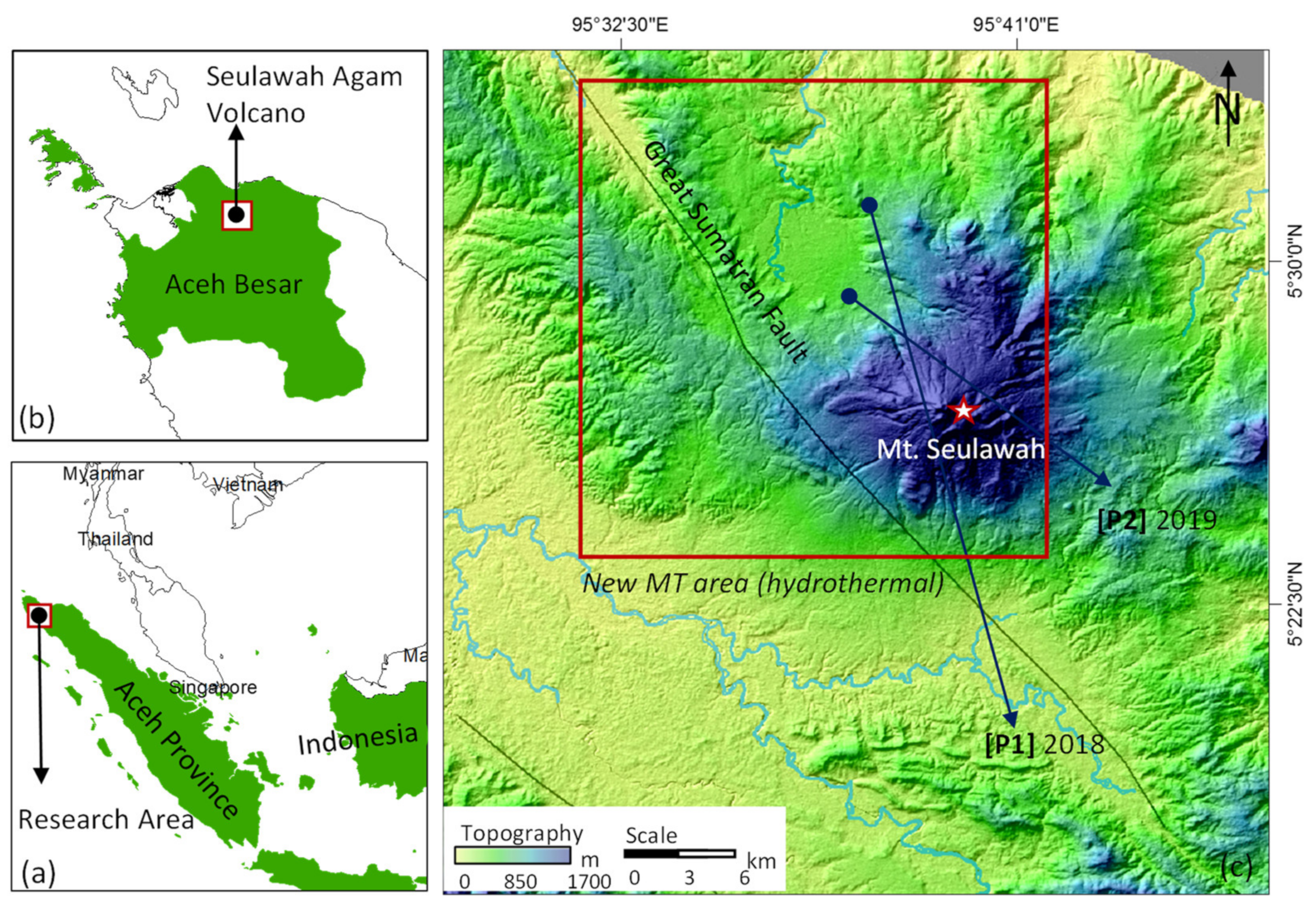
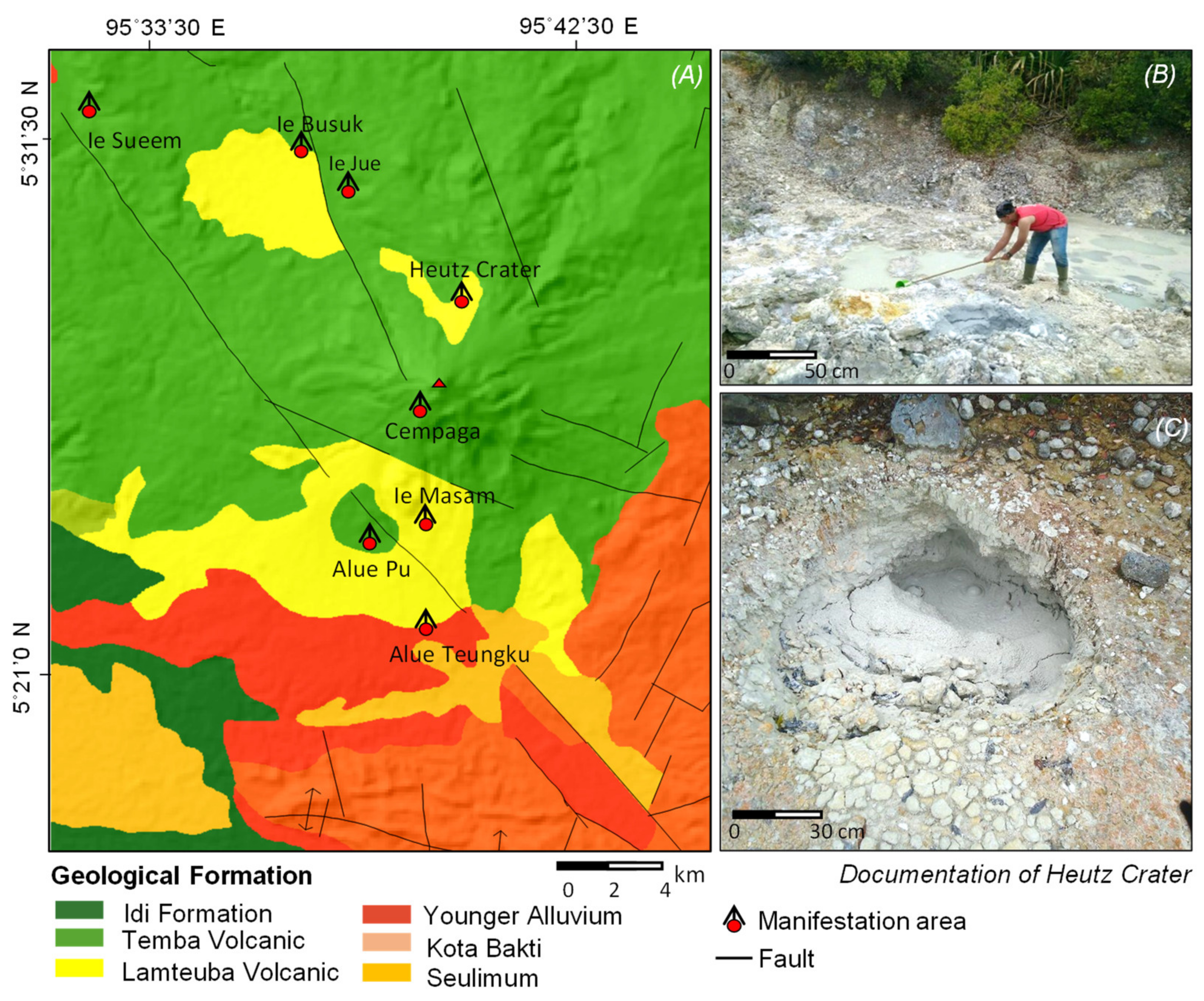

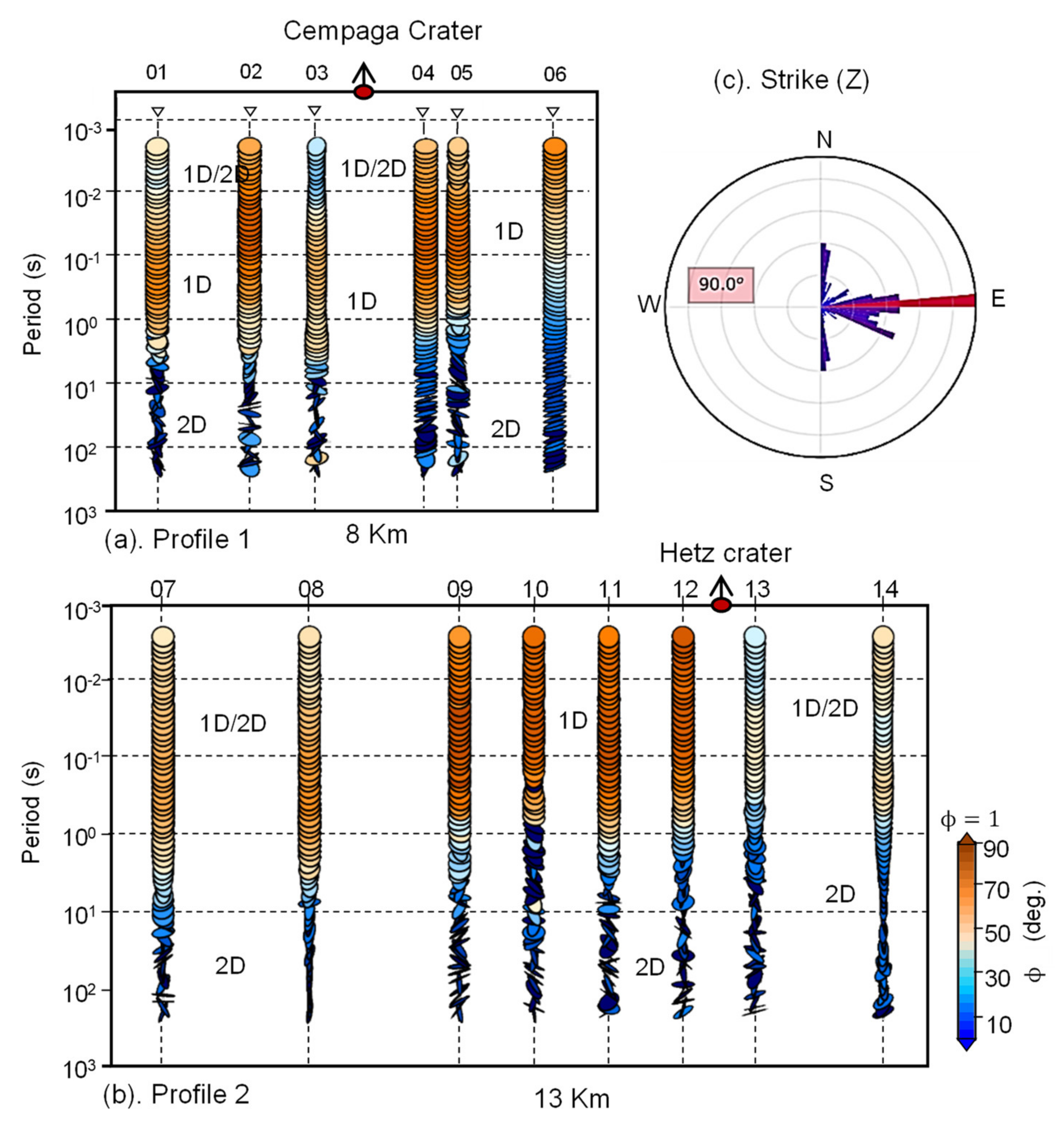
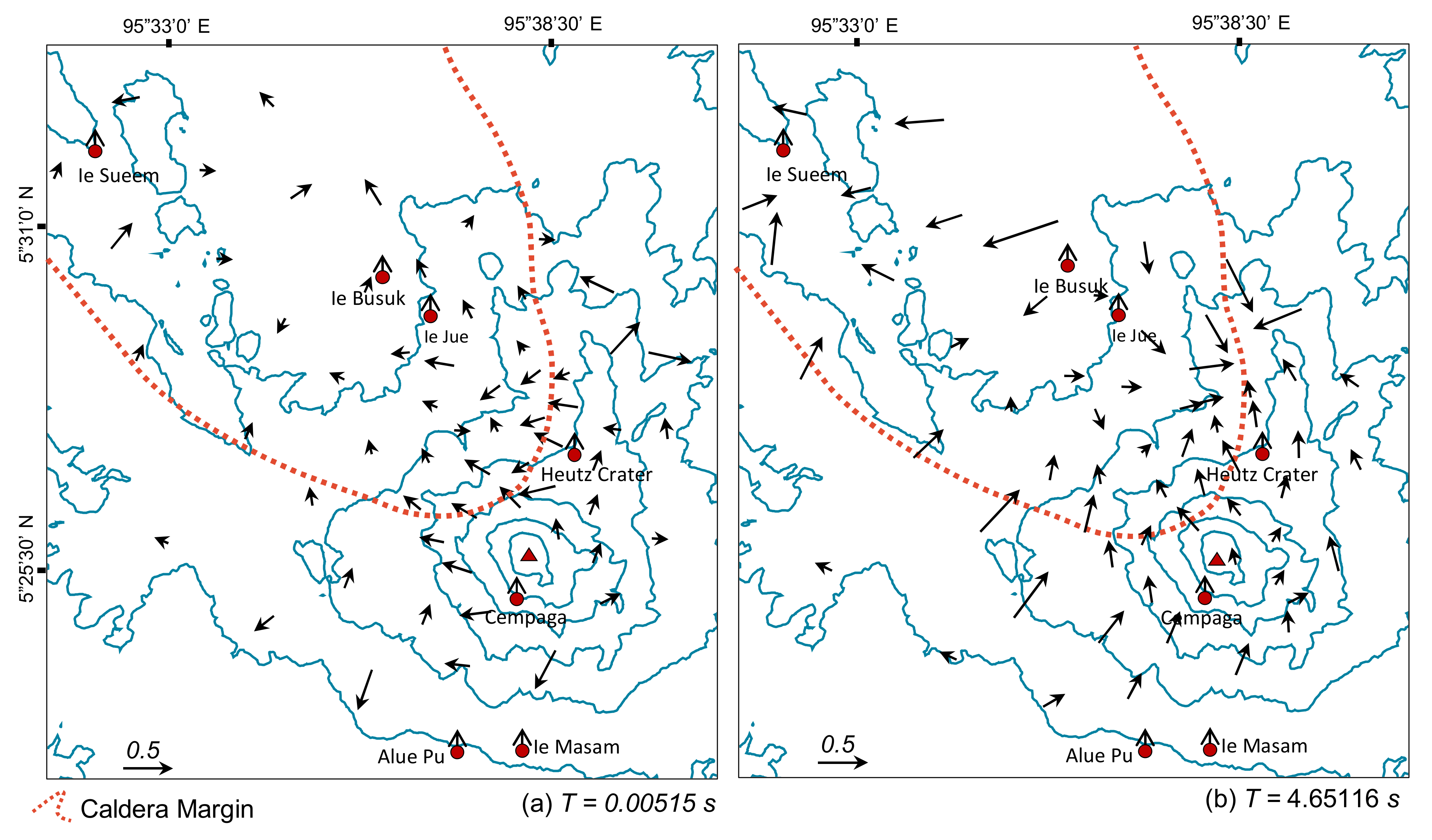


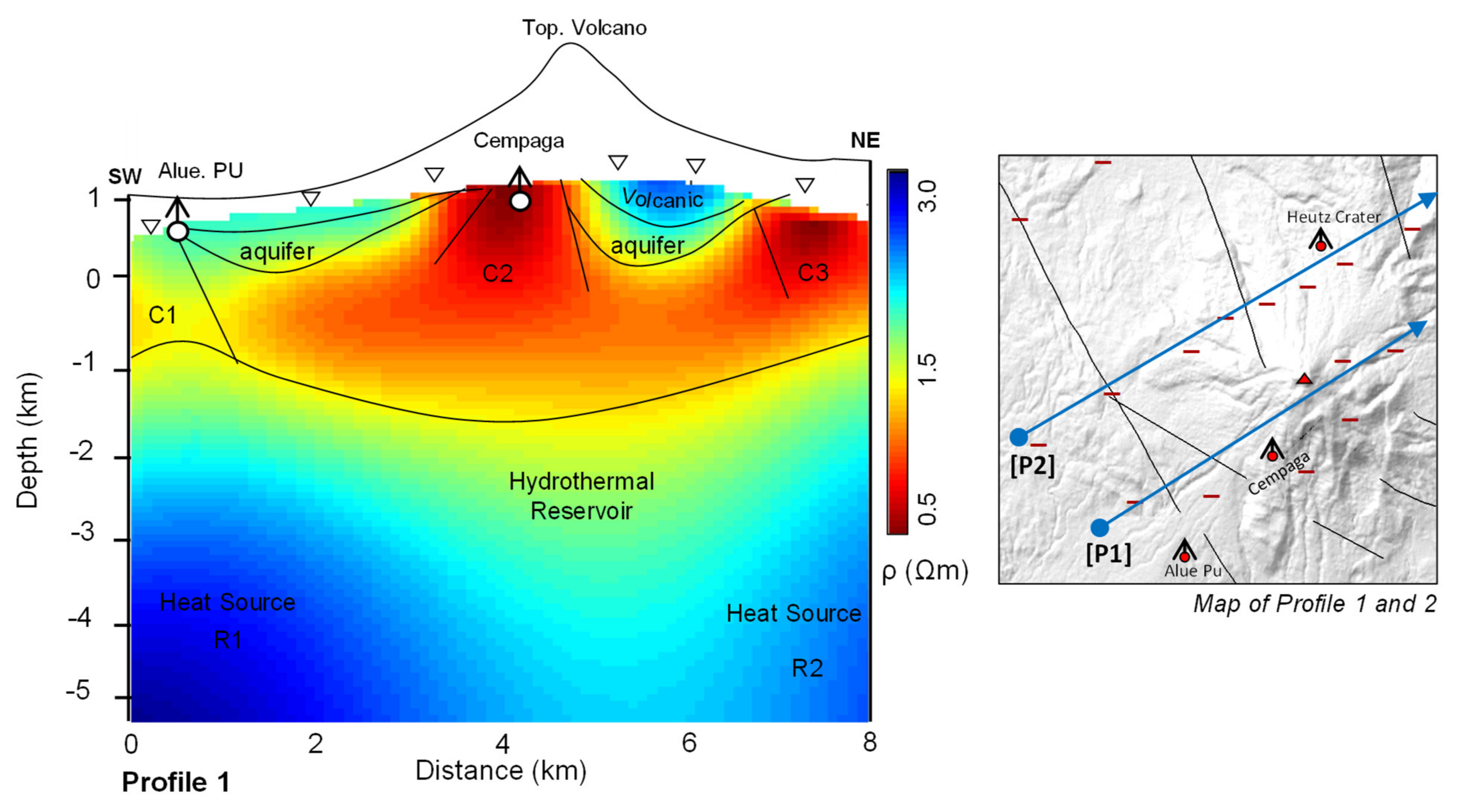

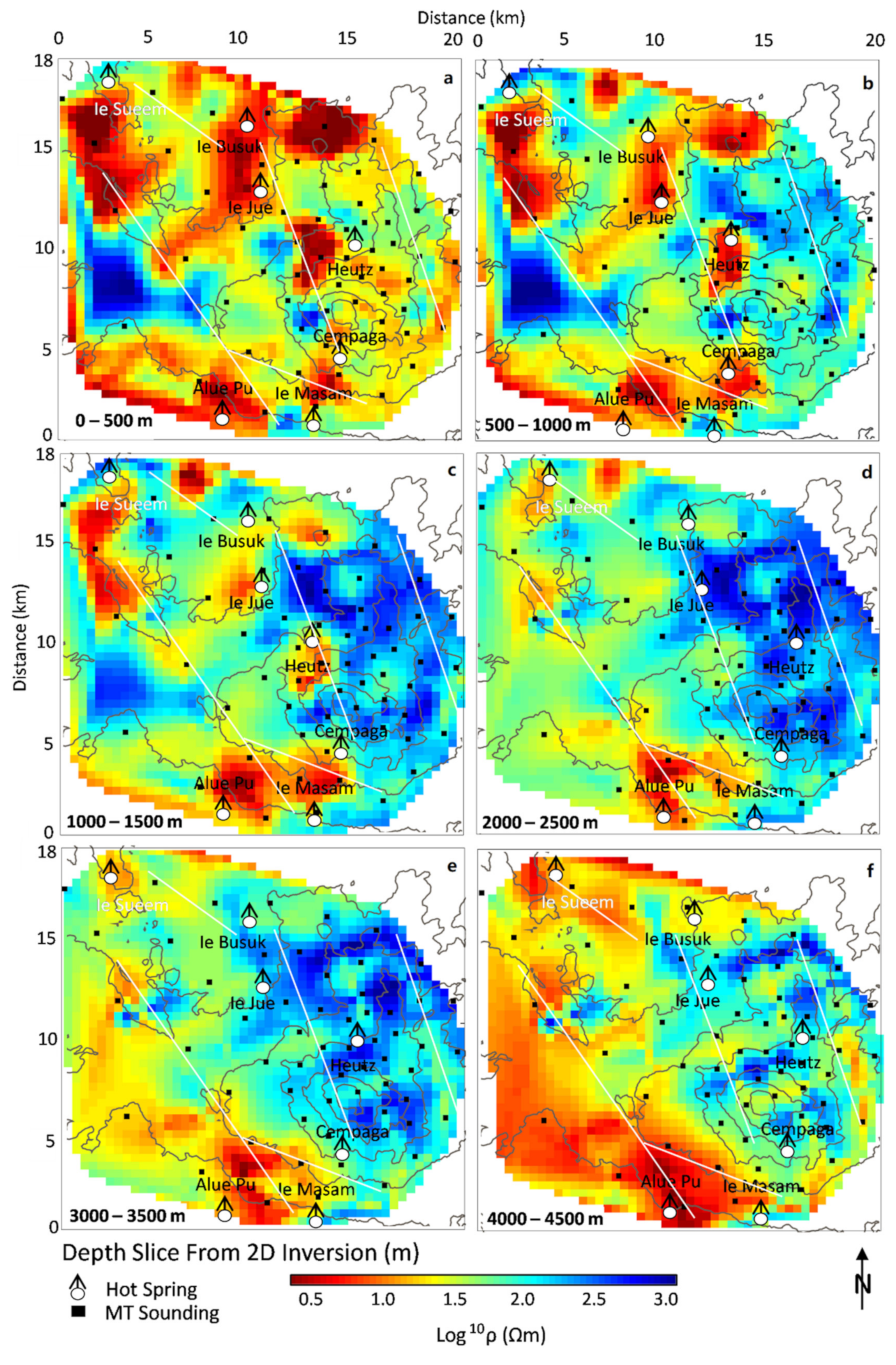

Publisher’s Note: MDPI stays neutral with regard to jurisdictional claims in published maps and institutional affiliations. |
© 2021 by the authors. Licensee MDPI, Basel, Switzerland. This article is an open access article distributed under the terms and conditions of the Creative Commons Attribution (CC BY) license (https://creativecommons.org/licenses/by/4.0/).
Share and Cite
Marwan, M.; Yanis, M.; Nugraha, G.S.; Zainal, M.; Arahman, N.; Idroes, R.; Dharma, D.B.; Saputra, D.; Gunawan, P. Mapping of Fault and Hydrothermal System beneath the Seulawah Volcano Inferred from a Magnetotellurics Structure. Energies 2021, 14, 6091. https://doi.org/10.3390/en14196091
Marwan M, Yanis M, Nugraha GS, Zainal M, Arahman N, Idroes R, Dharma DB, Saputra D, Gunawan P. Mapping of Fault and Hydrothermal System beneath the Seulawah Volcano Inferred from a Magnetotellurics Structure. Energies. 2021; 14(19):6091. https://doi.org/10.3390/en14196091
Chicago/Turabian StyleMarwan, Marwan, Muhammad Yanis, Gartika Setiya Nugraha, Muzakir Zainal, Nasrul Arahman, Rinaldi Idroes, Dian Budi Dharma, Deni Saputra, and Poernomo Gunawan. 2021. "Mapping of Fault and Hydrothermal System beneath the Seulawah Volcano Inferred from a Magnetotellurics Structure" Energies 14, no. 19: 6091. https://doi.org/10.3390/en14196091
APA StyleMarwan, M., Yanis, M., Nugraha, G. S., Zainal, M., Arahman, N., Idroes, R., Dharma, D. B., Saputra, D., & Gunawan, P. (2021). Mapping of Fault and Hydrothermal System beneath the Seulawah Volcano Inferred from a Magnetotellurics Structure. Energies, 14(19), 6091. https://doi.org/10.3390/en14196091









